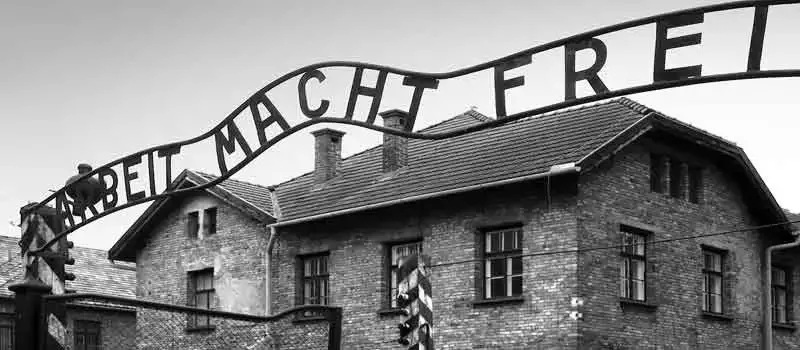- Military History
- Prisons, Prisoners & Camps
- Nazi Camps
- Auschwitz Concentration/Extermination Camp (Auschwitz-Birkenau) - Krakow, Poland (1940-1945)

Auschwitz Concentration/Extermination Camp (Auschwitz-Birkenau) - Krakow, Poland (1940-1945) The largest and most notorious German concentration and extermnation camp during World War II
Auschwitz (in German) or Oświęcim (in Polish) was the largest and most notorious German concentration camp during World War II. It was one of the so called combined camps (concentration and extermination camp) like the Majdanek concentration camp. Originally built as a military barracks, Auschwitz I received its first prisoners in June 1940 with 700 Polish Catholic political prisoners. Located 37 miles (60 km) west of Krakow in Poland, Auschwitz would eventually contain three major camps and 45 sub-camps. Birkenau (or Auschwitz II) opened in October 1941 and, from there on, the whole complex was better known as Auschwitz-Birkenau concentration camp and accommodated 100,000 prisoners.
Birkenau contained four gas chambers, and most of the people murdered at Auschwitz were killed here: one million Jews and 500,000 Polish Catholics, Gypsies, and Soviet POWs. Monowitz (or Auschwitz III) grew out of a camp that supplied slave labor for the nearby I. G. Farben synthetic rubber and oil plant.
Captivity at Auschwitz began with new prisoners at the railroad station in Birkenau. After having been transported like cattle for many hundreds of miles (kilometers), the prisoners were forced to form quickly into two lines, one for men and the other for women. The lines moved to a point where camp officers separated the prisoners again, this time into inmates who would become slave laborers and those who would be gassed immediately. As the new arrivals endured the selection process, a detachment of prisoners gathered up the possessions that had been left in the railroad cars. These possessions would eventually be sent to Germany to serve the war effort or to increase the wealth of high-ranking SS- Schutzstaffel and Nazi Party officials.

The prisoners who were not sent to the gas chambers were first sent to the quarantine camp. There, the prisoners' last remaining possessions were taken away from them, their heads were shaved (both men and women), and they were issued striped prison uniforms. Each prisoner was also registered and received an identification number, which was tattooed on the left arm. The life expectancy of these prisoners once they started working as slave laborers was only a few months. 405,000 people worked as slave laborers at Auschwitz.
The daily routine of the slave laborers at Auschwitz began when they woke up at dawn and were forced to stand at attention for the roll call. Any prisoners who could not remain standing for the roll call were immediately sent to the gas chambers. Prisoners then worked in the factories all day, received one wholly inadequate meal, stood for the evening roll call, and finally were allowed a few hours of sleep before the process started all over again. Some prisoners were neither gassed immediately nor sent to join the slave-labor force. These unfortunate individuals were the subjects of medical experiments carried out by camp doctors, the most notorious of whom was Dr. Josef Mengele, the "Angel of Death."
Despite the horrific conditions that existed in the camp, the prisoners constantly resisted their oppressors and 667 prisoners (almost all of them Poles) actually escaped from the camp; 270 of these were later recaptured and killed. In 1943, photographs of the mass executions taking place in Auschwitz were smuggled out by two Polish prisoners who escaped. Although these photos reached the Allied powers in London, the Allies refused to believe that they were authentic.
The mass killing in Auschwitz continued until November 1944, when the SS-Schutzstaffel dismantled the camp in the face of Soviet advances. When the Red Army liberated Auschwitz on 27 January 1945, only 7,650 sick prisoners remained, and the gas chambers and crematoria where destroyed. The buildings that remain have been established by the Poles as a memorial to the dead and a museum.
- Germany Nazi (1933-1945)
- Poland (since 1918)
Map
- {{#owner}}
- {{#url}} {{#avatarSrc}}
{{name}} {{/url}} {{^url}} {{#avatar}} {{& avatar}} {{/avatar}} {{name}} {{/url}} - {{/owner}} {{#created}}
- {{created}} {{/created}}























